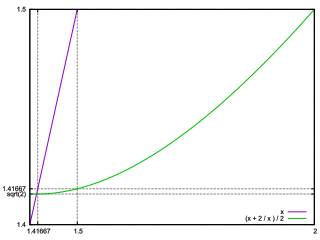Higher-order convergence algorithm for reciprocal and square root

Takayuki HOSODA
November 16, 2009
Reviced May 9, 2025

The Newton–Raphson method provides a first-order approximation of a function f(x) near an estimate xn. Its convergence rate can be improved by employing higher-order approximations.
In contexts where extended- or multiple-precision arithmetic is required,
recurrence formulas with higher-order convergence can significantly reduce computational cost by minimizing the number of iterations needed to reach the desired accuracy. This is particularly important in high-precision environments,
where multiplication tends to dominate the overall computation time. By reducing the number of required multiplications,
high-order recurrence formulas improve the efficiency of numerical methods.
The following examples illustrate such high-order methods applied to the computation of reciprocals and square roots.
 Japanese edition is here.
Japanese edition is here.
The recurrence formula for computing the reciprocal
1/Ausing Newton-Raphson method is given by
The number of correct significant digits doubles at each iteration.xn+1 = 2xn - Axn2In contexts where extended- or multiple-precision arithmetic is required, high-order convergence can significantly reduce the computational cost by minimizing the number of iterations needed to reach the desired accuracy.
Recurrence formula for
1/Awith cubic convergenceWith this method the number of correct significant digits roughly triples at each iteration.
Lethnbe the error inxn.hn = 1 - Axn
xn+1 = xn(1 + hn + hn2)
Recurrence formula for
1/Awith fourth order convergencehn = 1 - Axn
xn+1 = xn(1 + hn)(1 + hn2)Recurrence formula for
1/Awith fifth order convergence
xn+1 = xn(1 + (1 + hn2)(hn + hn2))
Recurrence formula for
√Aof cubic convergenceHowever, this method has the disadvantage of requiring a divisionA similar approach can be applied to the square root calculation. The standard Newton-Raphson recurrence for computing
√A(the square root ofA) is given by:xn+1 = (xn + A/xn)/2
A/xnat each step, which can be computationally expensive.
Instead, if we apply the Newton-Raphson method to compute1/√A, we can derive a more efficient recurrence formula.Newton-Raphson Recurrence for
1/√Axn+1 = xn(3 - Axn2)/2
Since
3/2and1/2are constants, s formula only involves multiplication—making it computationally more efficient. Once1/√Ais computed,√Acan be obtained simply as:As in the case of reciprocal approximation, using a higher-order recurrence for√A = A(1/√A)1/√Aleads to faster convergence. Below is a formula derived from the series expansion of1/√(1 - h).Recurrence formula for
1/√Aof cubic convergenceThe number of significant digits is tripled with each repetition.
hnis equal to the error ofxn.hn = 1 - A xn2
xn+1 = xn (1 + hn (4 + 3 hn) / 8)
Recurrence formula for 1 / √A with quartic convergence
hn = 1 - A xn2
xn+1 = xn(1 + hn(8 + hn(6 + 5 hn))/16)
Recurrence formula for 1 / √A with 5th-order convergence
hn = 1 - A xn2
xn+1 = xn(1 + (64hn + hn2(48 + 40hn + 35hn2))/128)
Recurrence formula for 1 / √A with 6th-order convergence
hn = 1 - Axn2
xn+1 = xn(1 + hn(1/2 + hn(3/8 + hn(5/16 + hn(35/128 + hn(63/256))))))
As in the case of
1/√A, we use the series expansion of√(1 - h).Recurrence formula for
√Awith 6th-order convergencehn = 1 - A/xn2
xn+1 = xn(1 - hn(1/2 + hn(1/8 + hn(1/16 + hn(5/128 + hn7/256)))))Recurrence formula for
1/∛A (= A-1/3) with 6th-order convergencehn = 1 - Axn3
xn+1 = xn + xnhn(1/3 + hn(2/9 + hn(14/81 + hn(35/243 + hn(91/729)))))Recurrence formula for
1/∜A (= A-1/4)with 6th-order convergencehn = 1 - Axn4
xn+1 = xn + xnhn(1/4 + hn(5/32 + hn(15/128 + hn(195/2048 + hn(663/8192)))))
Listing 1:
C implementation example of square root with 6th-order convergence
double _sqrt(double x) { double a, d, h; int e; /* Lookup table for scaling factor based on exponent parity */ static const double scf[3] = { M_SQRT2, 1.0, M_SQRT1_2 }; if (x < 0) return NAN; /* Return NaN for negative input */ if (x == 0) return x; /* sqrt(0) = 0 */ /* Range reduction: x = d * 2^e, where d ∈ [0.5, 1) */ d = frexp(x, &e); /* Initial approximation of 1 / sqrt(d) using 3rd-order polynomial */ /* Approximation error |err| < 5e-4 over d ∈ [0.5, 1] */ a = 2.605008 + d * (-3.6382977 + d * (2.9885788 - 0.9557557 * d)); /* Scaling: convert 1/sqrt(d) to 1/sqrt(x) */ a = ldexp(a * scf[1 + e % 2], -e / 2); /* Compute residual h = 1 - x * a^2, then apply correction */ /* 6th-order convergence in final refinement */ h = 1 - x * a * a; a *= (1 + h * (0.5 + h * (0.375 + h * (0.3125 + h * (0.2734375 + h * 0.24609375))))); return x * a; /* Return sqrt(x) = x * (1 / sqrt(x)) */ }

![[Mail]](/~lyuka/images/mail.gif)



